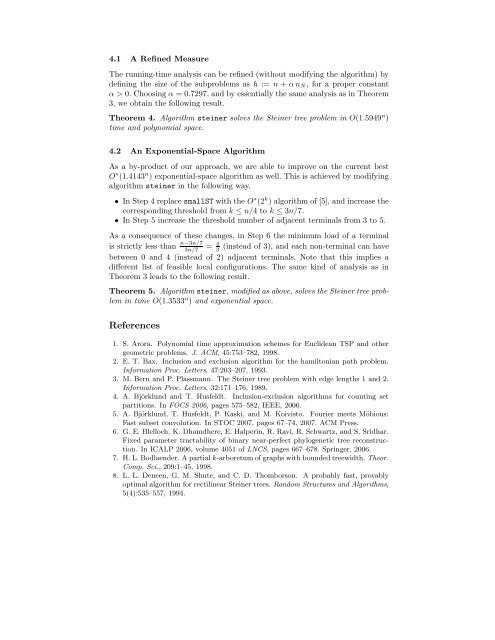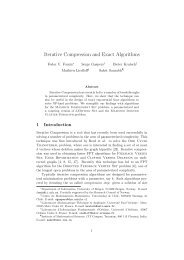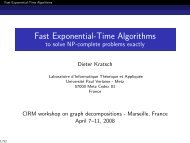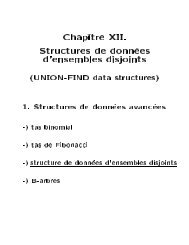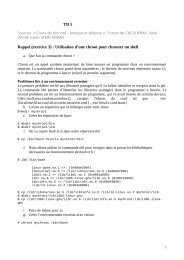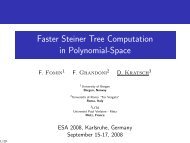Fast Steiner tree computation in polynomial space - Lita
Fast Steiner tree computation in polynomial space - Lita
Fast Steiner tree computation in polynomial space - Lita
Create successful ePaper yourself
Turn your PDF publications into a flip-book with our unique Google optimized e-Paper software.
4.1 A Ref<strong>in</strong>ed Measure<br />
The runn<strong>in</strong>g-time analysis can be ref<strong>in</strong>ed (without modify<strong>in</strong>g the algorithm) by<br />
def<strong>in</strong><strong>in</strong>g the size of the subproblems as h := n + αnN , for a proper constant<br />
α>0. Choos<strong>in</strong>g α =0.7297, and by essentially the same analysis as <strong>in</strong> Theorem<br />
3, we obta<strong>in</strong> the follow<strong>in</strong>g result.<br />
Theorem 4. Algorithm ste<strong>in</strong>er solves the <strong>Ste<strong>in</strong>er</strong> <strong>tree</strong> problem <strong>in</strong> O(1.5949 n )<br />
time and <strong>polynomial</strong> <strong>space</strong>.<br />
4.2 An Exponential-Space Algorithm<br />
As a by-product of our approach, we are able to improve on the current best<br />
O ∗ (1.4143 n ) exponential-<strong>space</strong> algorithm as well. This is achieved by modify<strong>in</strong>g<br />
algorithm ste<strong>in</strong>er <strong>in</strong> the follow<strong>in</strong>g way.<br />
• In Step 4 replace smallST with the O ∗ (2 k ) algorithm of [5], and <strong>in</strong>crease the<br />
correspond<strong>in</strong>g threshold from k ≤ n/4 tok ≤ 3n/7.<br />
• In Step 5 <strong>in</strong>crease the threshold number of adjacent term<strong>in</strong>als from 3 to 5.<br />
As a consequence of these changes, <strong>in</strong> Step 6 the m<strong>in</strong>imum load of a term<strong>in</strong>al<br />
is strictly less than n−3n/7 4<br />
3n/7 = 3 (<strong>in</strong>stead of 3), and each non-term<strong>in</strong>al can have<br />
between 0 and 4 (<strong>in</strong>stead of 2) adjacent term<strong>in</strong>als. Note that this implies a<br />
different list of feasible local configurations. The same k<strong>in</strong>d of analysis as <strong>in</strong><br />
Theorem 3 leads to the follow<strong>in</strong>g result.<br />
Theorem 5. Algorithm ste<strong>in</strong>er, modified as above, solves the <strong>Ste<strong>in</strong>er</strong> <strong>tree</strong> problem<br />
<strong>in</strong> time O(1.3533n ) and exponential <strong>space</strong>.<br />
References<br />
1. S. Arora. Polynomial time approximation schemes for Euclidean TSP and other<br />
geometric problems. J. ACM, 45:753–782, 1998.<br />
2. E. T. Bax. Inclusion and exclusion algorithm for the hamiltonian path problem.<br />
Information Proc. Letters, 47:203–207, 1993.<br />
3. M. Bern and P. Plassmann. The <strong>Ste<strong>in</strong>er</strong> <strong>tree</strong> problem with edge lengths 1 and 2.<br />
Information Proc. Letters, 32:171–176, 1989.<br />
4. A. Björklund and T. Husfeldt. Inclusion-exclusion algorithms for count<strong>in</strong>g set<br />
partitions. In FOCS 2006, pages 575–582, IEEE, 2006.<br />
5. A. Björklund, T. Husfeldt, P. Kaski, and M. Koivisto. Fourier meets Möbious:<br />
<strong>Fast</strong> subset convolution. In STOC 2007, pages 67–74, 2007. ACM Press.<br />
6. G.E.Blelloch,K.Dhamdhere,E.Halper<strong>in</strong>,R.Ravi,R.Schwartz,andS.Sridhar.<br />
Fixed parameter tractability of b<strong>in</strong>ary near-perfect phylogenetic <strong>tree</strong> reconstruction.<br />
In ICALP 2006, volume 4051 of LNCS, pages 667–678. Spr<strong>in</strong>ger, 2006.<br />
7. H. L. Bodlaender. A partial k-arboretum of graphs with bounded <strong>tree</strong>width. Theor.<br />
Comp. Sci., 209:1–45, 1998.<br />
8. L. L. Deneen, G. M. Shute, and C. D. Thomborson. A probably fast, provably<br />
optimal algorithm for rectil<strong>in</strong>ear <strong>Ste<strong>in</strong>er</strong> <strong>tree</strong>s. Random Structures and Algorithms,<br />
5(4):535–557, 1994.


